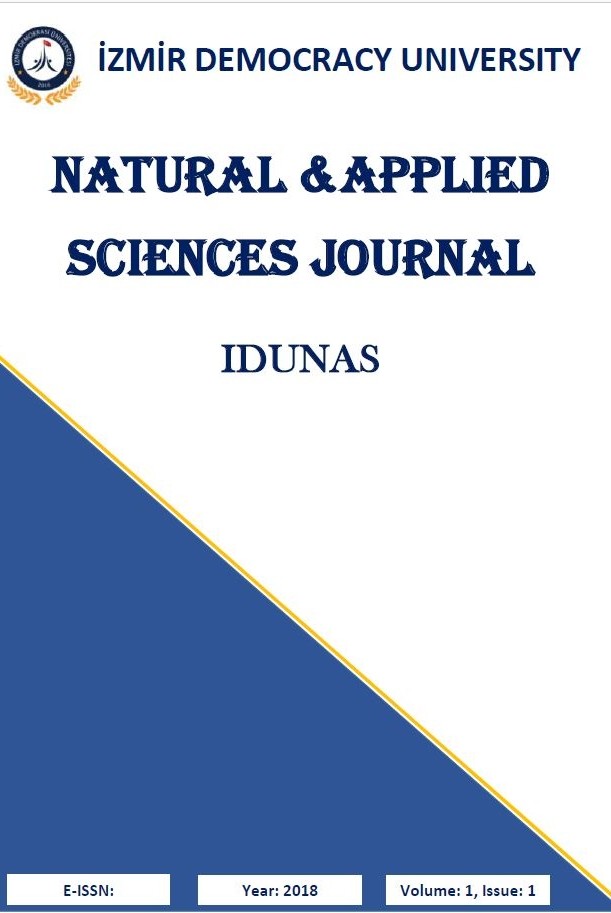Kanser Tanı ve Tedavisinde Manyetik Nanopartikülker
Son zamanlarda, geleneksel kanser tanı ve tedavisinin ortaya koyduğu yan etkileri azaltmak ya da ortadan kaldırmak için etkili yaklaşımlar bulmaya yönelik önemli çalışmalar yapılmıştır. Bu nedenle, manyetik nanopartiküller (MNP) benzersiz fiziksel özellikleri, manyetik duyarlılık, biyouyumluluk ve kararlılıklarından dolayı çok ilgi çekmiştir. Özellikle in vivo biyomedikal uygulamalarda kullanılacak manyetik nanomalzemeler; boyut, morfoloji, yüzey kimyası, biyobozunurluk ve isteğe bağlı spesifik hedefleme gibi özel kriterleri karşılamaya ihtiyaç duyar. Biyomedikal uygulamalar için, nanopartiküller en çok hipertermi, ilaç salımı ve Manyetik Rezonans Görüntüleme (MRG) için kontrast ajanları olarak kullanılmaktadır.
Anahtar Kelimeler:
Kanser, Manyetik Nanopartikül, Manyetik Rezonans Görüntüleme, Hipertermi, İlaç Salımı
Magnetic Nanoparticles In The Diagnosis And Treatment Of Cancer
Recently, significant studies have been carried out to find effective approaches to reduce or eliminate the side effects of traditional cancer diagnosis and treatment. In this context, magnetic nanoparticles (MNP) have attracted much attention due to their unique physical properties, magnetic susceptibility, biocompatibility and stability. Magnetic nanoparticles particularly to be used for in vivo biomedical applications need to fulfill special criteria such as size, morphology, surface chemistry, biodegradation, and specific targeting in biomedical applications, the nanoparticles are mostly used as contrast agents for hyperthermia, drug release and Magnetic Resonance Imaging (MRI).
___
- Filippousi, M., Papadimitriou, S.A., Bikiaris, D.N., Pavlidou, E., Angelakeris, M., Zamboulis, D., Tian, H., Van Tendeloo, G. (2013). Novel core–shell magnetic nanoparticles for Taxol encapsulation in biodegradable and biocompatible block copolymers: preparation, characterization and release properties. International Journal of Pharmaceutics, 448, 221–230.
- Singh, A., Sahoo, S.K. (2014). Magnetic nanoparticles: a novel platform for cancer theranostics. Drug Discovery Today, 19, 474–481.
- Acharya S, Sahoo S.K. (2011). PLGA nanoparticles containing various anticancer agents and tumour delivery by EPR effect. Advanced Drug Delivery Reviews, 63, 170-183.
- Jin, R., Lin, B., Li, D., Ai, H. (2014). Superparamagnetic iron oxide nanoparticles for MR imaging and therapy: design considerations and clinical applications. Current Opinion in Pharmacology, 18, 18–27.
- Ling, D., Park, W., Park, S.J., Lu, Y., Kim, K.S., Hackett, M.J., Kim, B.H., Yim, H., Jeon, Y.S., Na, K., Hyeon, T. (2014). Multifunctional tumor pH-sensitive self-assembled nanoparticles for bimodal imaging and treatment of resistant heterogeneous tumors. Journal of American Chemical Society, 136 (15), 5647-5655.
- Muthiah, M., Park, I.K., Cho, C.S. (2013). Surface modification of iron oxide nanoparticles by biocompatible polymers for tissue imaging and targeting. Biotechnology Advances, 31, 1224-1236.
- Zhang, S., Gong, M., Zhang, D., Yang, H., Gao, F., Zou, L. (2014). Thiol-PEG-carboxyl-stabilized FeO/Au nanoparticles targeted to CD105: synthesis, characterization and application in MR imaging of tumor angiogenesis. European Journal of Radiology, 83 (7), 1190-1198.
- Zhang, L., Zhou, H., Belzile, O., Thorpe, P., Zhao, D. (2014). Phosphatidylserine-targeted bimodal liposomal nanoparticles for in vivo imaging of breast cancer in mice. Journal of Controlled Release, 183, 114-123.
- Weissleder, R., Nahrendorf, M., Pittet, M.J. (2014). Imaging macrophages with nanoparticles. Nature Materials, 13, 125-138.
- Hervault, A., Thanh, N.T.K. (2014). Magnetic nanoparticle-based therapeutic agents for thermo-chemotherapy treatment of cancer. Nanoscale 6, 11553–11573.
- Mondol, S., Manivasagan, P., Bharathiraja, S., Moorthy, M.S., Nguyen, V.T., Kim, H.H., Nam, S.Y., Lee, K.D., Oh, J. (2017). Hydroxyapatite coated iron oxide nanoparticles: a promising nanomaterial for magnetic hyperthermia cancer treatment. Nanomaterials, 7 (12), 426.
- Huang, H.S., Hainfeld, J.F. (2013). Intravenous magnetic nanoparticle cancer hyperthermia. International Journal of Nanomedicine, 8, 2521-2532.
- Basel, M.T., Balivada, S., Wang, H., Shrestha, T.B., Seo, G.M., Pyle, M., Abayaweera, G., Dani, R., Koper, O.B., Tamura, M., Chikan, V., Bossmann, S.H., Troyer, D.L. (2012). Cell-delivered magnetic nanoparticles caused hyperthermia-madiated increased survival in a murine pancreatic cancer model. International Journal of Nanomedicine, 7, 297-306.
- Kumar, B.N.P., Puvvada, N., Rajput, S., Sarkar, S., Das, S.K., Emdad, L., Sarkar, D., Venkatesan, P., Pal, I., Dey, G., Konar, S., Brunt, K.R., Rao, R.R., Mazumdar, A., Kundu, S.C., Pathak, A., Fisher, P.B., Mandal, M. (2015). Sequential release of drugs from hollow manganese ferrite nanocarriers for breastcancer theraphy. Journal of Materials Chemistry B, 3, 90-101.
- Shakeri-Zadeh, A., Khoee, S., Shiran, M.B., Sharifi, A.M., Khoei, S. (2015). Synergistic effects of magnetic drug targeting using a newly developed nanocapsule and tumor irradiation by ultrasound on CT26 tumors in BALB/c mice. Journal of Materials Chemistry B, 3, 1879-1887.
- Hałupka-Bryl, M., Asai, K., Thangavel, S., Bednarowicz, M., Krzyminiewski, R., Nagasaki, Y. (2014). Synthesis and in vitro and in vivo evaluations of poly(ethylene glycol)-block-poly(4-vinylbenzylphosphonate) magnetic nanoparticles containing doxorubicin as a potential targeted drug delivery system. Colloids and Surfaces B, 118, 140–147.
- ISSN: 2645-9000
- Başlangıç: 2018
- Yayıncı: İzmir Demokrasi Üniversitesi
Sayıdaki Diğer Makaleler
Elektroeğirme Yöntemi ile Fibröz Doku İskelelerinin Üretimi
Kanser Tanı ve Tedavisinde Manyetik Nanopartikülker
Osteokondral Doku Mühendisliği,
Yüksek İrtifada Yapılan Egzersizin Oksidatif Stres Düzeyine Etkisi
Betonarme Binalarda Deprem Derz Mesafesinin İncelenmesi
Murat Emre KARTAL, Muhammet Karabulut, Elif Özil, Rukiye Ünlü
